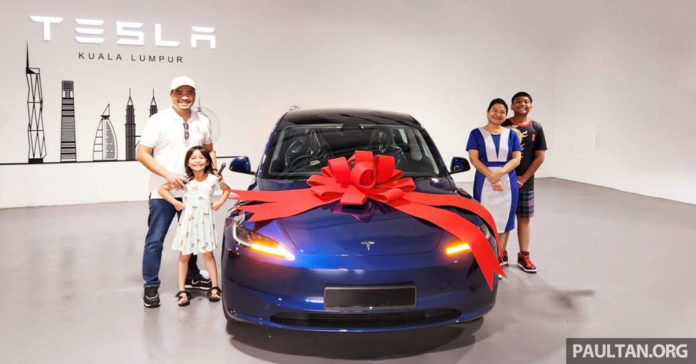By and large, buying a new car is a simple enough affair, with virtually all the matters of process being handled by someone else once you’ve decided you rather fancy that fresh metal and have put a down-payment for it. Of course, there’s always a modicum of involvement on your part along the way, but for the most the entire run is usually painless and sweat-free, the aspects predictable right down to final delivery.
So when a carmaker decides to go the direct route and have you handle all the things a salesman usually would, all in the interest of cost savings to buyers, so it goes, it really can’t be that tough, right? Well, unless you’re familiar with the workings, it can be, as seen from a number of social media posts from Malaysian Tesla buyers during the initial delivery period for the Model 3 Highland, highlighting among other things the chase for paperwork and visit/s to JPJ to the futility of calling Tesla delivery assistants for clarification.
While the noise has quietened a fair bit on those channels, the buying process itself remains constant, and so we decided to find out what’s involved in the DIY route and what early Highland buyers, having run that gauntlet, thought about the overall experience and how different it is to other brands in terms of interaction and the assorted elements (insurance transfer, JPJ no plate, car loan, etc), with the idea of giving those who are eyeing a Tesla purchase down the line an inkling of what to expect and prepare for.
We tried reaching out privately to a couple of owners, but they didn’t respond. Then, by chance, I got a WhatsApp message from my friend Barry Lim, who wanted to ask about the BYD Seal. It turned out he had bought a Model 3 Highland, and had taken delivery of it a couple of days after the first deliveries of the car began. Seeing as he was in that early mix, I asked him to provide notes about the buying process to be fleshed out into a story.
Barry, being Barry, decided not to stick to the brief and opted to go one better, providing the following long-form piece – which has only been given minor edits for house-style and brevity – below. In it, he not only details the buying experience and things to look out for, but also the reasons as to why he decided to go green and went for a Tesla, even going so far as to volunteer an opinion on the EV vs ICE debate. We’ll let him take centre stage from here.
Pre-purchase, or why I bought a Tesla
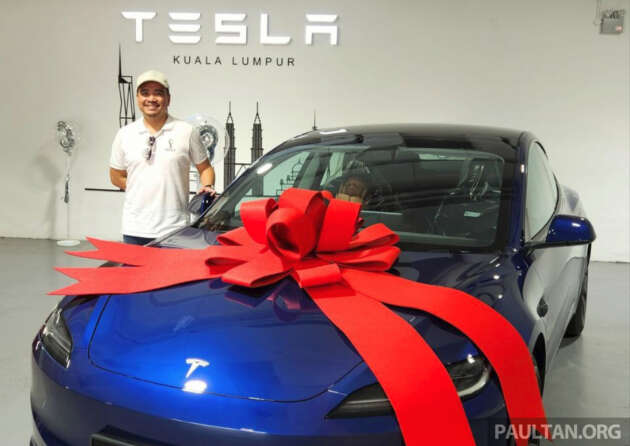
First off, here’s my buyer profile:
- Pre-middle-age male, married, two school going kids
- Klang Valley-based upper middle-class landed house
- Fortunate history of nice past and current cars (mostly non-Japanese), but this is my first BEV
My two constant areas of interest in life have always been cars and tech. EVs are an amalgamation of both, with Teslas especially being so, having been described as “a gadget that so happens to take the shape of a car.”
I’ve toyed with the idea of an EV for many years, especially since the missus has been onboard the environmental express for a long time, i.e., the vegetarian, cycle and walk everywhere type. However, the lack of EV access and choice because of the non-conducive Malaysian car industry put the plan onto the back of a snail all this while. That was until the previous government mooted the EV incentives a couple of years ago, which changed the market dynamics to the benefit of the ‘EV-ready consumer’.
Fact is, EVs are more expensive to manufacture compared to ICE. It is also a much newer segment with much smaller economies of scale as compared to the incumbent option. This simply means that not only are the bill of materials (concentrated on the batteries) more costly, there is also less volume from customer demand, and shorter production lifespans.
This final point is often missed by many: as EV technologies (batteries, motors, platforms) are newer, sitting on the early non-mature/nascent part of the ‘technology adoption curve’, not only are there (relatively) less customers to spread the development cost, there’s also less time for the technology to be ‘market competitive’ before the ‘next best technology’ comes around or gets discovered. I’ll come back to this point again later.

Moving on, even as the government EV incentive plans came into being, the major manufacturers still decided they wanted healthier margins despite being able given a decent period of tax-free status for their fully-imported EV models. A personal example I will highlight (the Korean brands are another good example) is the MINI Cooper SE that I was keen on. It was an early-entry model with an attractive ‘pre tax-free’ price of RM225k. Tax-free pricing was announced initially at RM184k, but very quickly revised upwards to just below RM200k.
This gave EV ready customers like me a feeling of being taken for a ride despite government incentives, and that there was little to be gained as an early adopter in Malaysia. Together with my recent realisation that buying a two to three-year old second-hand car isn’t as difficult and risky as it used to be, I thought I’d hold off on an EV purchase and aim for a tasty ‘posher’ used Mercedes-Benz EQE/Audi Q8 e-tron/Porsche Taycan once those hit the second-hand market.
Heck, my bet was almost sure-proof in my head as the general Malaysian car-buying public is very much risk-adverse and always bikin tak serupa cakap (exhibit A: “I will definitely buy a manual version of XXX if they offered it here”).
This prudent strategy fell apart upon the announcement of Tesla’s entry into Malaysia. At first, the expectation was that their core models like the Y and 3 would likely be priced to compete with the likes of the Mercedes-Benz EQB/BMW iX3 and Mercedes-Benz EQA/Hyundai Ioniq 5 respectively. After all, the Chinese entrants were already pushing closer to the RM200k figure than the RM100k end. But Tesla Malaysia got to work very quickly.
When it first announced the Model Y priced from RM199k (which we initially booked), and then the updated facelift Model 3 Highland at RM189k, we didn’t have to think long and hard about putting the RM1k (non-refundable and not part of the car price) booking fee. This was done on the very first day the Model 3 Highland was announced for Malaysia, which was September 1, 2023.
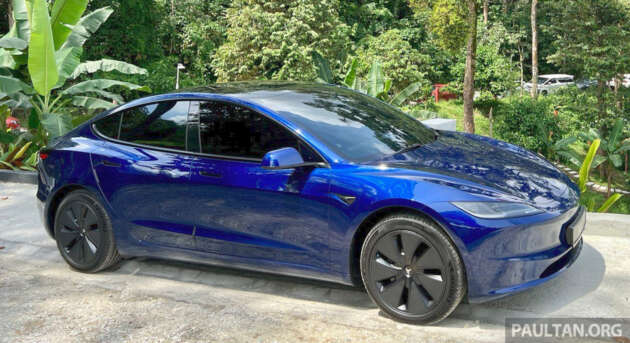
The Model 3 Highland that I ordered was a Long Range version (RM218k), with a blue exterior (and standard black interior) adding RM5k to that. Additionally, I opted for the Enhanced Auto Pilot (EAP), which added a further RM16k, making the purchase price RM239k.
Pre-delivery, otherwise known as waiting
From readings of Tesla’s marketing model overseas, it wasn’t much of surprise to me that many of the steps and process of buying a new car with it would be very much different from the experience of buying a new car with practically any other brand in Malaysia. The required milestones are the same i.e., book, get your hire-purchase loan, insurance NCD transferred, registration with JPJ (and plate number ‘interchange’ in our case) and delivery/pick-up.
However, unlike dealing with just one sales agent (and maybe one banker), here you may not even have a SA at all (such as our case because we booked online – for those that booked a Tesla in person, the SA’s job ends upon taking your order).
For most of the first month, there was nothing to be done and no known updates to our purchase besides the earlier announced ‘year-end’ delivery promise. We too did not do anything, and indeed I did not even make any real attempt to dispose of the wife’s current car, which the Model 3 was to replace.
Some time in October (month two), we were contacted by what Tesla calls a delivery agent, or DA in short. The DA’s job is supposed to help ‘guide’ the buyer through the necessary steps and process until the car actually gets delivered to him/her.


So, step one was to get the bank loan approved. If you don’t have your own banker, Tesla Malaysia will offer you contact numbers for you to reach out to. Its panels are Maybank and Ambank, I believe. We went with Maybank through another referral contact (from a Tesla group setup by some early buyers – we called ourselves Tesla MIM for so-called ‘Made in Malaysia,’ and yes, we know it’s not made in Malaysia).
Once the loan came through, there was again radio silence and the only notable activity I did the rest of October was to go check-out the physical car for the first time in their newly-launched HQ in Cyberjaya. No test drives were available, but that was fine as we had already experienced the old pre-facelift Model 3 as a holiday rental for almost a month a year prior overseas, and there were proxy test drive videos by Hafriz Shah to keep things going. Oh, congratulations on the recent nuptials, Hafriz!
In early November (month three), we were contacted by the DA that our actual car had been allocated to us in the system. This was immediately reflected in the Tesla app with an assigned VIN number (you get an account on the app upon making the booking). With the VIN, we were then supposed to proceed with the remaining steps.
Now, since in our case we wanted to keep the number from the old car and have it transferred to the new Tesla, this process (by JPJ) called “interchange” added a complexity that isn’t there for buyers that opt for new numbers.
The interchange process requires that an old plate number (i.e., used on any existing vehicle) be immediately transferred to the new vehicle and cannot be kept ‘floating’ for any period. As the Tesla had not arrived (represented by a K1 form issued by Kastam upon arrival of the actual car into the country), we could not do that as yet.


Also to be kept in mind that at the same time, the old car must be then issued a ‘new number’ during the interchange process i.e., any old car (already registered with JPJ before) cannot have an ‘old number’ assigned to it – either the car or the number has to be new or unregistered per JPJ, which some say is to protect the used-car AP business model.
So, despite our loan and insurance (issued without a plate number attached) all ready and done up (not without its own drama, as even the banks are not entirely sure about Tesla Malaysia’s processes), the key steps of (1) interchange, and (2) registering of the actual car was dramatically left till the morning of our assigned delivery date, in this case December 1, 2023.
JPJ is where I want to be, not
Basically, we needed to bring two forms to JPJ: (1) the B2 form issued by Puspakom upon inspection of old car for interchange purposes, and (2) the K1 form issued by Kastam upon arrival of the Tesla at a Malaysian port. Tesla Malaysia could not get us the K1 form until the early morning on Friday, December 1, the same day we were supposed to collect our car at 2.45pm.
With some work already scheduled for that Friday morning, we could only get to a JPJ just before it closed its morning session for Friday prayers. We were literally the last customer to be transacted before the JPJ office grilles were shut!
With the newly-issued JPJ registration grant for the Tesla in our hands, we went back home, picked up the kids, got into a Grab car and made our way to Tesla Cyberjaya for our assigned collection slot.
Actual delivery

The Tesla delivery process was also one that was very different from our past experiences picking up a brand new ride, especially in one key aspect: customers were assigned into batches and practically collected their respective cars together. Things might have changed since the initial period, but here’s what customers who took deliveries of their cars early on experienced.
First, you arrive and get ushered to the registration table (much like when you arrive for say, a conference) where you pick out your name from a long list on a printed xls table. Second, you are then told to huddle together in the waiting area behind said registration table, with a water cooler and self-service coffee machine, which looked out-of-service when we were there.
Third, you then get huddled into a briefing room (the size of perhaps a typical apartment’s master bedroom) with a Chinese (by heritage) guy speaking in a real – as opposed to television – American accent (to remind us that Tesla is an American brand?) about the basics of Tesla ownership and operations of the car e.g., swiping on the centre screen for drive, reverse, as well as buttons on the steering instead of a signal stalk. The BMW owners in the room didn’t seem to care about this, for some reason.
Finally, for the moment of truth, you are ushered in a group to the adjacent delivery hall (large enough for three to four cars concurrently in there), which opens up through a single ramp to the car park area outside the building.
We were then quite randomly put into a sequence to get our keycards – marked by the respective registration number – and had the option to (A) go find your car on the parking lot, get in, drive off, or (B) do A but then wait for a slot to drive your car into the delivery hall, put on the large red ribbon and take pictures, then drive off. Our family decided to do option B just for the heck of it in order to get the picture you see here.
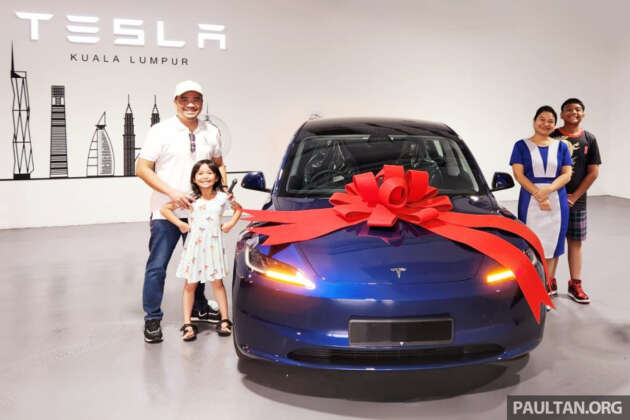
Pro Tip: As this is your one and only chance to use its ‘delivery supercharger’ for free, consider plugging in for a quick top-up before you leave the parking lot as all the cars we noticed on the day had approximately 60% or so of charge only. Not an issue, but if you’re not in a hurry, then why not get some extra electric juice into your car for free?
So, after exactly three months from booking (in our case), we were driving home as one of the very first owners of the Tesla Model 3 Highland in the world. Is it really a big deal? As ‘just another car’, maybe not. But as an EV, it apparently is a ‘big deal’. Why? Read my summation below.
Post-delivery thoughts
Globally, Tesla has somehow (not something I personally understand) built an almost fanatical fan-base. In some ways, it can be likened to the Apple brand that is part aspirational, part nonsensical. Is it because of Elon Musk? Despite popular belief, Elon did not start Tesla. He just had money to invest it in, fire the two actual founders, make himself chairman and CEO, and arguably make the Tesla ‘vision’ a reality. So, is Tesla what it is because of Elon? Because of the real risk of being hunted by Tesla’s fanboys, I will not state my position publicly.
Are we enjoying the Model 3 Highland as a product? That’s an easy yes! Compared to the pre-facelifted Model 3, this is a product that has matured in very measurable ways, beneficial to buyers. As mentioned earlier, we had the Model 3 as a rental for a decent enough period, clocking in some good road-tripping miles in it. The biggest gripes were the harsh ride, especially in the rear seats, worse than average noise levels, and a not very attractive exterior design. The facelift fixes all the above, and yes, I like the updated looks very much.
Is there anything that makes Tesla the default go-to EV brand of choice, at least for now? Yes, only one. The Supercharger network. This very nice value proposition really makes the brand stand out, not just for consumers, but on a wider scale as an ‘ecosystem builder’ at an industry level. With its own charging network, Tesla as a company has to put effort (and money) into not just its cars and the necessary supplier network of partner firms, but also R&D into charging and its technical protocols, deal with energy suppliers and land-owners as well as manage the operations across all locations.
Proof that it has succeeded here is that in other markets where Tesla has been operating for years now, the Tesla superchargers are known to be highly reliable with easier availability than other public chargers that presumably are the main business of their respective operators with a wider addressable market of many more EV brands. However, is this a deal breaker for other EVs? I think not.
To EV, or not to EV?
As to the on-going “EV vs non-EV” debate of today, my response is this (for now, until I think of something more brilliant): will you ever refill your ICE car at a public petrol station if you had your own petrol station at home with RON 95 at approximately half the price per litre?
You see, as long as you fit the criteria of landed-living (which many Malaysians do, and others can too as long as they are willing to either move a little further from the city or buy older landed properties instead of only considering new developments) and ideally have another ICE car in the household for the occasional balik kampung trips, you have the perfect use-case of an EV consumer.
Ignoring the upfront purchase price, which is tax-free for now despite costing more than the equivalent-sized ICE option, the operating cost of an EV is approximately half for every kilometre travelled in the Malaysian context (not expected to change much even as petrol prices become unsubsidised, as TNB pricing is also expected to rise).
Factor in the total cost-of-ownership where there are little to no scheduled servicing intervals (no major oil changes), negligible wear-and-tear components besides tyres and wipers, and lastly the higher energy conversion efficiencies of electric motors compared to dinosaur-juiced engines, and the EV proposition starts to become a viable alternative.
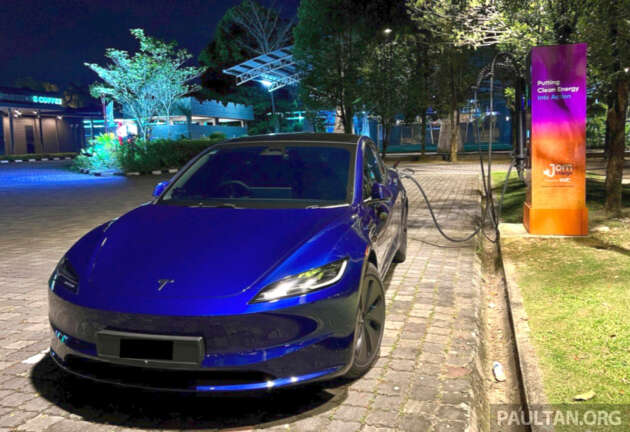
In fact, I would like to emphasise the word “alternative.” EVs will not replace ICEs any time soon. Likely not in our lifetime. Even in mature economies where new ICE models will be banned in about a decade’s time, existing ICE vehicles will continue to run for the next decade or two. That means 30 more years in places like western Europe and maybe North America. In other economies of Asia, Africa and South America, let’s perhaps add another two more decades to that. So that’s 50 years of arguing if you still want to adopt a hard position on the EV vs non-EV debate, no? Quite tiring, if you ask me.
Instead, accept that EVs are just another track of vehicles to give us consumers more options. Both have their pros and cons and respective use-cases e.g., if you do outstation trips very often, an EV most certainly cannot be your (main) car of choice. Are Teslas for that matter perfect? Not at all.
In my own experience and opinion (yours may vary depending on your point of comparison), the much-hyped Tesla Autopilot (remember that we opted for the EAP add-on too) is more hype than substance, at this juncture performing worse than that on my other current car, and there’s also the deletion of the ubiquitous ultrasonic sensors to rely exclusively on the so-called ‘Tesla-vision’ and the unnecessary stalkless driving experience to contend with.
Aside from these minor niggles and the teething issues of the purchase process, our ride in the EV bandwagon so far has been a good one. Is it for everyone? Nope. Is it good for the environment? Notice I didn’t bring up that topic at all, but if you must discuss it, remember that EV development is at best two decades old versus a century for ICE development, so think about the implications of that for a moment.
Looking to sell your car? Sell it with myTukar.

